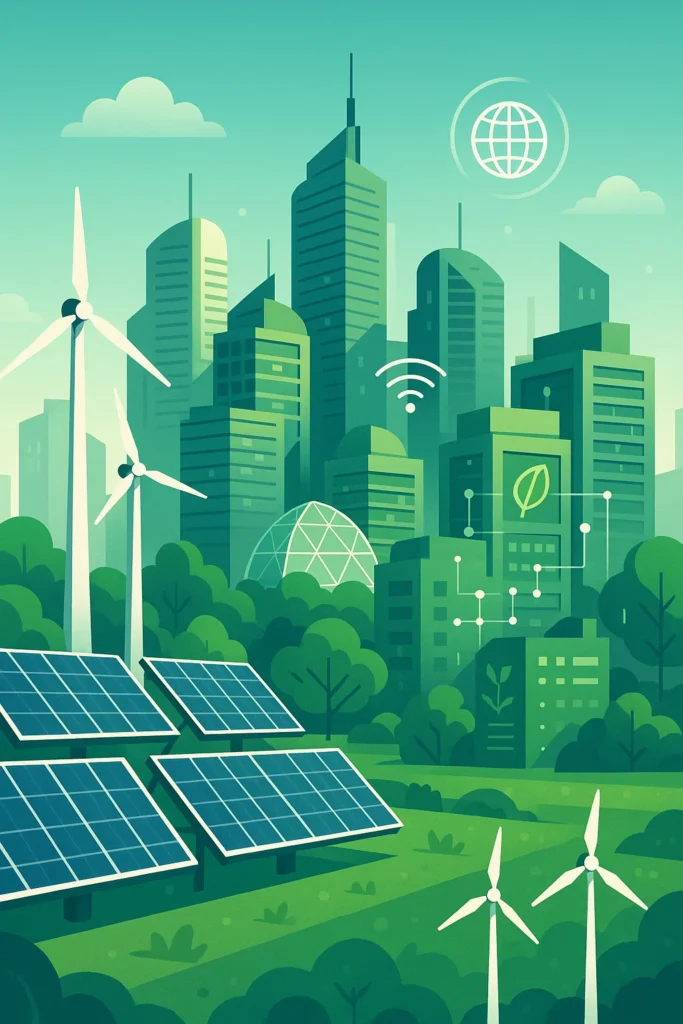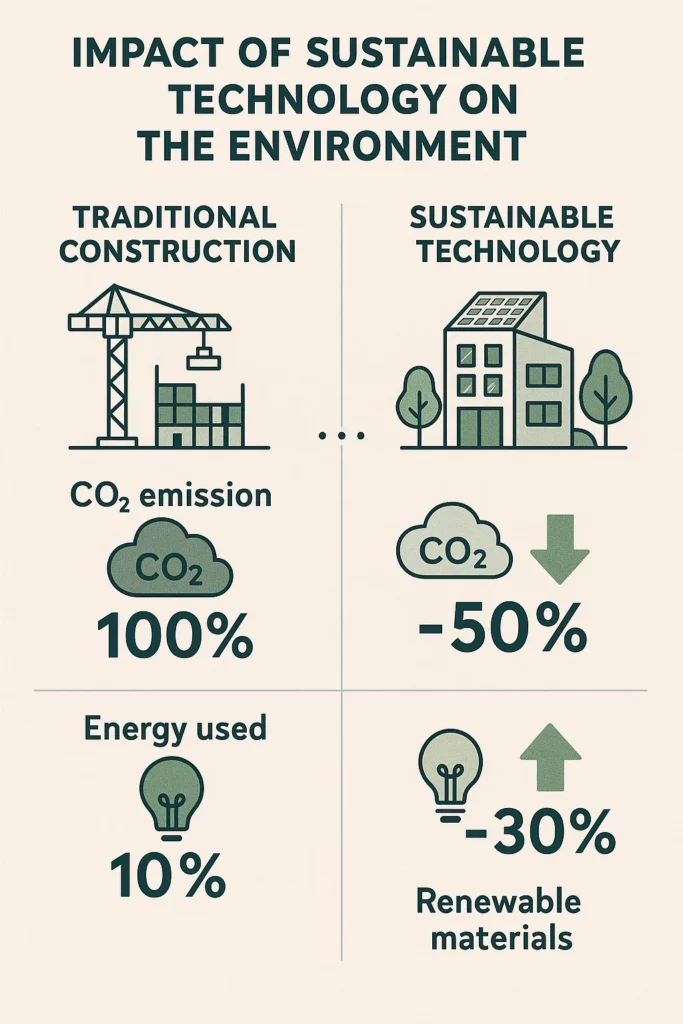
Why Sustainable Technology Matters Now
Every few seconds, the planet reminds us that time is running short. Rising sea levels, scorching summers, and unpredictable storms no longer feel like distant warnings they’re here. The United Nations reports that global greenhouse gas emissions must fall by 45% by 2030 to prevent irreversible climate damage. That’s a massive challenge. But it’s also a powerful opportunity one where technology can become humanity’s most effective ally.
Sustainable technology is the invisible backbone of a cleaner future. It’s not just about solar panels or wind farms; it’s the smart sensors, data-driven systems, and circular designs that help entire cities and industries operate efficiently with minimal environmental harm.
From artificial intelligence predicting energy demand to IoT devices monitoring water usage in real time, the world is entering an era where sustainability is powered by innovation. According to a 2024 Gartner report, over 70% of global CEOs have integrated sustainability into their corporate strategy with technology leading the way.
Understanding Sustainable Technology
At its core, sustainable technology refers to systems, devices, and innovations that are designed to preserve natural resources, reduce emissions, and support long-term ecological balance. It’s technology with purpose built not only to perform, but to sustain.
| Problem | Cause | Sustainable Tech Solution | Global Impact |
|---|---|---|---|
| High carbon emissions | Fossil fuel dependency | Renewable energy systems (solar, wind, hydro) | Reduced global warming potential |
| Resource waste | Inefficient production | Circular manufacturing & recycling tech | Less landfill and pollution |
| Water scarcity | Overuse and leakage | Smart water sensors and AI irrigation | Conservation of freshwater |
| Urban congestion | Vehicle overpopulation | Electric mobility, smart traffic grids | Lower CO2 and improved air quality |
These solutions don’t exist in isolation. They’re part of a global ecosystem of technologies from renewable power to digital twins that simulate entire cities for better planning.

The Link Between Technology and Environmental Sustainability
Sustainability and technology have become inseparable. The Internet of Things (IoT) allows industries to track energy, emissions, and waste in real time. Artificial intelligence analyzes that data to optimize operations cutting costs and environmental impact simultaneously.
Take the example of smart agriculture. In Kenya and India, farmers now use IoT soil sensors and AI weather forecasting tools that optimize irrigation and fertilizer use. This approach not only reduces water waste by up to 30%, according to the World Bank, but also increases crop yields and stabilizes food systems.
In manufacturing, AI-driven energy management platforms (like those from Siemens and Schneider Electric) can automatically adjust machinery based on energy demand, reducing consumption during non-peak hours.
And in cities like Copenhagen and Singapore, smart grids balance renewable energy flow dynamically proving that efficiency and sustainability can scale together.
“Technology isn’t just a tool; it’s a multiplier for change.”
Maria Gonzalez, Techoble.com
Technology’s Contribution to Sustainable Development Goals (SDGs)
The United Nations Sustainable Development Goals (SDGs) serve as the blueprint for a sustainable future. Out of the 17 goals, technology plays a critical role in at least 10 particularly those connected to energy, water, industry, and climate.
| SDG | Target | Example Tech | Result |
|---|---|---|---|
| SDG 6 – Clean Water & Sanitation | Reduce water waste | IoT leak detection systems | 25% savings in city water grids |
| SDG 7 – Affordable & Clean Energy | Increase renewables | Smart solar microgrids | Electrification in rural Africa |
| SDG 9 – Industry, Innovation & Infrastructure | Support sustainable industries | Circular manufacturing systems | 30% waste reduction |
| SDG 11 – Sustainable Cities | Build resilient infrastructure | Smart transport networks | Reduced urban air pollution |
| SDG 13 – Climate Action | Combat climate change | AI carbon tracking & offset tools | Transparent emissions reporting |
In 2023, the World Economic Forum emphasized that digital technologies could help reduce global emissions by up to 20% by 2030, mainly through smarter grids, logistics, and material reuse.
Real-World Examples of Sustainable Technology in Action
1. Solar Microgrids in Rural Africa
More than 600 million Africans still lack reliable electricity. Yet, small villages across Kenya, Rwanda, and Nigeria are now powered by solar microgrids independent renewable systems that store excess energy using smart batteries.
Projects like Powerhive and M-KOPA Solar are transforming energy access, proving that sustainability can empower rather than limit growth.
2. Smart Waste Management in Singapore
Singapore’s Smart Nation initiative uses AI-driven sensors inside trash bins to optimize collection routes and prevent overflow. The result: a 60% reduction in waste-collection fuel costs and cleaner neighborhoods powered entirely by data.
3. Tesla’s Gigafactory Recycling Model
Tesla’s Gigafactory in Nevada is more than a manufacturing site it’s a closed-loop recycling ecosystem. Old battery cells are disassembled and reused, creating a self-sustaining cycle of production that reduces both waste and material extraction.
These real-world implementations remind us that sustainable technology is not science fiction it’s today’s best business strategy.
Challenges in Achieving Global Environmental Goals
Sustainable technology holds promise, but scaling it globally faces several obstacles:
| Barrier | Challenge | Potential Solution |
|---|---|---|
| High initial costs | Expensive clean tech infrastructure | Green finance incentives, carbon credits |
| Policy fragmentation | Lack of global coordination | International tech-sharing frameworks |
| Data inequality | Limited access in developing regions | Open-source sustainability platforms |
| Cybersecurity risks | Vulnerable smart grids and IoT systems | Encrypted data systems and regulatory standards |
Another issue lies in the digital divide. The same technology that helps one country reduce emissions might be inaccessible to another due to cost or connectivity gaps. Bridging this divide requires global collaboration and transparent data sharing.
“Without inclusivity, sustainability cannot scale.”
UNEP Climate Action Report 2024
The Role of Governments and Corporations
Both policymakers and corporations are now recognizing that green growth is good economics. Governments are incentivizing renewable energy and circular industries, while corporations embed sustainability into their DNA.
- The European Union introduced the Green Deal, aiming for carbon neutrality by 2050.
- The United States passed the Inflation Reduction Act, allocating billions for clean tech innovation.
- China leads in renewable manufacturing, producing over 80% of global solar panels.
Corporations, too, are investing heavily:
- Apple powers all global facilities with 100% renewable energy.
- Google’s data centers now use AI to reduce cooling energy by 30%.
- Microsoft plans to be carbon negative by 2030 through carbon capture tech.
The message is clear: innovation and responsibility can grow side by side.
The Future of Sustainable Technology
Looking ahead to 2030 and beyond, technology will redefine sustainability in ways we’re only beginning to imagine.
By 2050, cities may function as living ecosystems powered by renewable energy, built from biodegradable materials, and managed by AI-driven governance systems that balance human and environmental needs.
Emerging frontiers include:
- Transparent solar glass: turns windows into power sources.
- Biodegradable electronics: devices that dissolve safely after use.
- Green hydrogen: clean fuel to decarbonize industries and transport.
- Digital twins: 3D models of cities that simulate carbon emissions before construction begins.
According to McKinsey’s 2025 sustainability outlook, industries that adopt green technologies early could see a 30–40% cost reduction in energy and resource management within a decade.
(Infographic: Smart City Sustainability Dashboard showing metrics like CO₂ reduction, renewable usage, and AI monitoring.)
Step-by-Step Path to Greener Cities
Building greener cities requires a roadmap a series of interconnected actions blending policy, technology, and community engagement.
- Integrate Renewable Energy Systems
Solar rooftops, offshore wind farms, and local microgrids ensure cleaner, distributed power. - Adopt Smart Transportation Networks
EVs, intelligent traffic systems, and shared e-mobility reduce both emissions and congestion. - Implement Digital Twin City Planning
Governments like Dubai and Helsinki already use digital twins to predict urban growth and optimize resources. - Support Green Startups and Incentives
Funding climate-tech startups fosters innovation while creating local jobs. - Measure and Report Sustainability Outcomes
Data transparency through dashboards and IoT metrics keeps citizens and policymakers accountable.
(Visual: Engineers installing solar panels – human collaboration for sustainable urban growth.)
Advanced Tools and Platforms Driving Change
Several modern platforms already accelerate sustainability adoption:
- Microsoft Cloud for Sustainability – helps companies track emissions and energy performance.
- Google Earth Engine – provides satellite data to monitor deforestation and land use.
- IBM Envizi – simplifies ESG reporting with AI analytics.
- Siemens MindSphere – connects industrial IoT systems for real-time energy optimization.
These aren’t future ideas; they’re tools available right now for any organization serious about accountability.
Expert Insights and Global Perspectives
“Digital technology can deliver up to one-fifth of the carbon reduction needed to meet the 1.5°C target by 2030.”
World Economic Forum, 2023
“Sustainability has evolved from a moral imperative to a strategic differentiator.”
Gartner, Sustainability Trends Report 2024
When data, design, and determination meet, sustainability moves from concept to culture. Experts agree that the next decade will define whether humanity’s digital revolution becomes our greatest ally or our biggest regret.
Practical Checklist for Sustainable Technology Adoption
Here’s a simplified checklist any organization, city, or school can use:
- ✅ Conduct a sustainability assessment.
- ✅ Prioritize high-impact areas (energy, water, waste).
- ✅ Adopt renewable energy systems or carbon-offset tools.
- ✅ Digitize data tracking (IoT or smart dashboards).
- ✅ Train staff and stakeholders in sustainability practices.
- ✅ Report transparently share progress publicly.
- ✅ Reinvest savings into future innovation.
Small steps today can create monumental change tomorrow.
Final Thoughts Before You Try It Yourself
The future isn’t waiting. Every solar panel installed, every smart meter deployed, and every line of sustainable code written brings us closer to global balance.
Technology can’t replace human responsibility but it can amplify it. Our tools are smarter than ever, but it’s still our choices that shape the outcome.
Sustainable technology isn’t just the next innovation wave it’s the foundation for survival and progress in the 21st century. And if we choose to wield it wisely, the planet we leave behind might just be cleaner, smarter, and more connected than ever before.